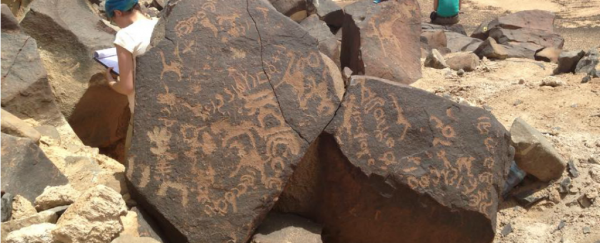Archaeologists have discovered thousands of 2,000-year-old inscriptions and rock carvings known as petroglyphs inside Jordan's Black Desert region - a barren landscape sitting near the Syrian border.
In addition to providing new details about an ancient civilisation that might have stretched all the way back to 200 BC, the inscriptions are evidence that the region was once home to a diverse culture, despite its harsh and desolate environment.
"Nowadays, the Jebel Qurma area, and the Black Desert in general, is a highly inhospitable area, very arid and difficult to cross," project leader Peter Akkermans, from Leiden University in the Netherlands, told Owen Jarus at Live Science.
For reference, here's the Black Desert today:
The team says that despite what it looks like now, the area – known as Jebel Qurma – was once full of trees, animals, and of course humans, who appeared to thrive there over 2 millennia ago.
In fact, the region's landscape might have thrown off archaeologists in the past who deemed it inhospitable.
"Jordan's extensive basalt-strewn north-eastern desert (or Black Desert) has attracted very little archaeological attention so far," the team writes.
"From an archaeological perspective, the vast basalt expanse is still one of the most poorly known parts of Jordan in particular and the Near East in general."
The newly found rock inscriptions now provide proof of human inhabitants, and the team has uncovered thousands of them so far.
They say that all of the inscriptions are written in the ancient Safaitic alphabet, which was used in the area now occupied by modern Jordan and Syria, and they suggest that the people who left them were likely nomadic.
"There are literally many thousands of Safaitic inscriptions and petroglyphs in the Jebel Qurma region, which suggests that people intensively used the area," Akkermans told Live Science.
Most of the inscriptions are of animals, such as gazelles and lions, while the ones that include text are, for the most part, just people's names. Why they're written like that remains a mystery.
"The precise reason for producing rock art - inscriptions and/or representations - is still unclear and open to discussion. What was the message which the producers of the rock art tried to convey?" said Akkermans.
Despite having so many examples to evaluate, there's still a lot that needs to be done if researchers hope to understand the culture that once called the Black Desert home.
The team notes that understanding the culture's nomadic lifestyle is of utmost importance, though there aren't many other details as to who wrote the inscriptions, or what their culture was truly like.
"Mobility was vital to the desert communities which were organised along lines of tribal affiliation and pastoral subsistence," the team writes. "Hence, insight into mobility is at the very heart of interpretation and essential to the proposed study."
Even more tantalising is how the landscape changed so much in just 2,000 years. If the team is correct, the region was once a much more hospitable place full of trees, wildlife, and fresh water.
"Our excavation at one site revealed masses of charcoal from the 3rd century AD, which appeared to represent several taxa [groups] of trees, which needed water year-round," Akkermans said.
"Hence, the conditions in at least the third century AD may have been quite different from today. This is certainly something I wish to explore in the next field seasons, by coring for pollen."
The Black Desert is also home to strange, wheel-shaped geometric patterns, which can only be seen from above, but are older than Peru's Nazca Lines:
 Google Earth
Google Earth
Hopefully, learning more about the new-found inscriptions will reveal more details about the societies that once made their home in the Black Desert and surrounding areas.
The inscriptions and petroglyphs are being analysed under more scrutiny, and so far, there's no word when more details will be released.
The team's work has been chronicled in a series of studies that can be found here, and a new report in the American Journal of Archaeology is reportedly coming soon.

